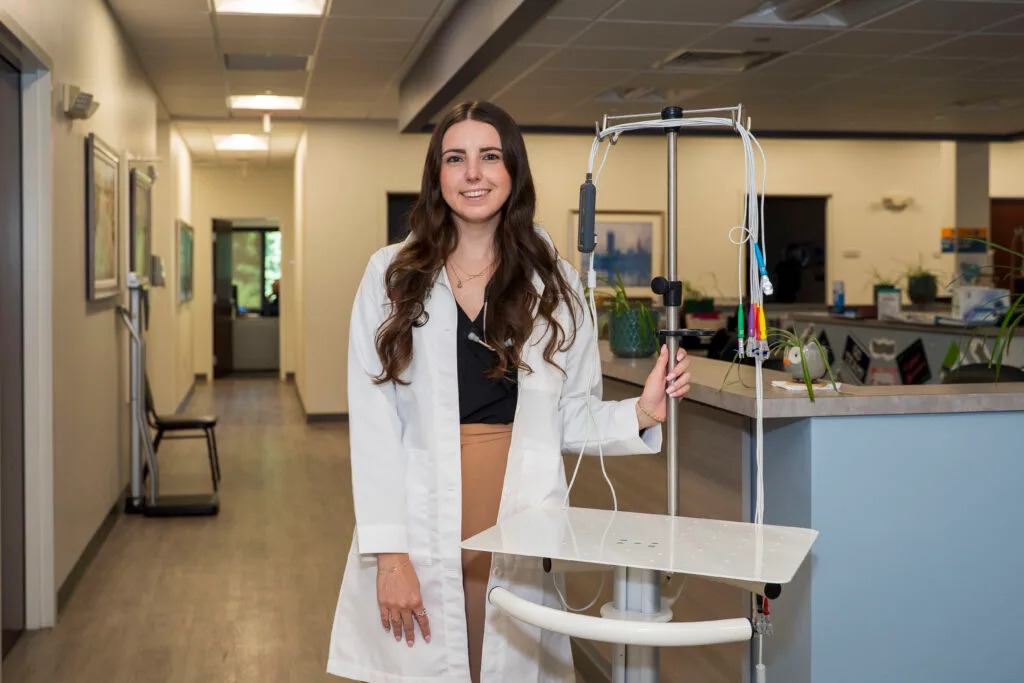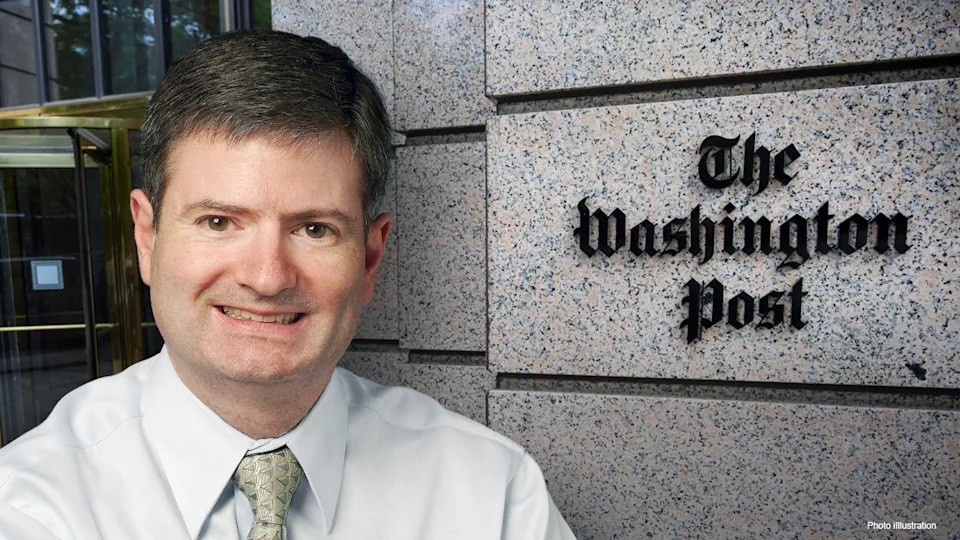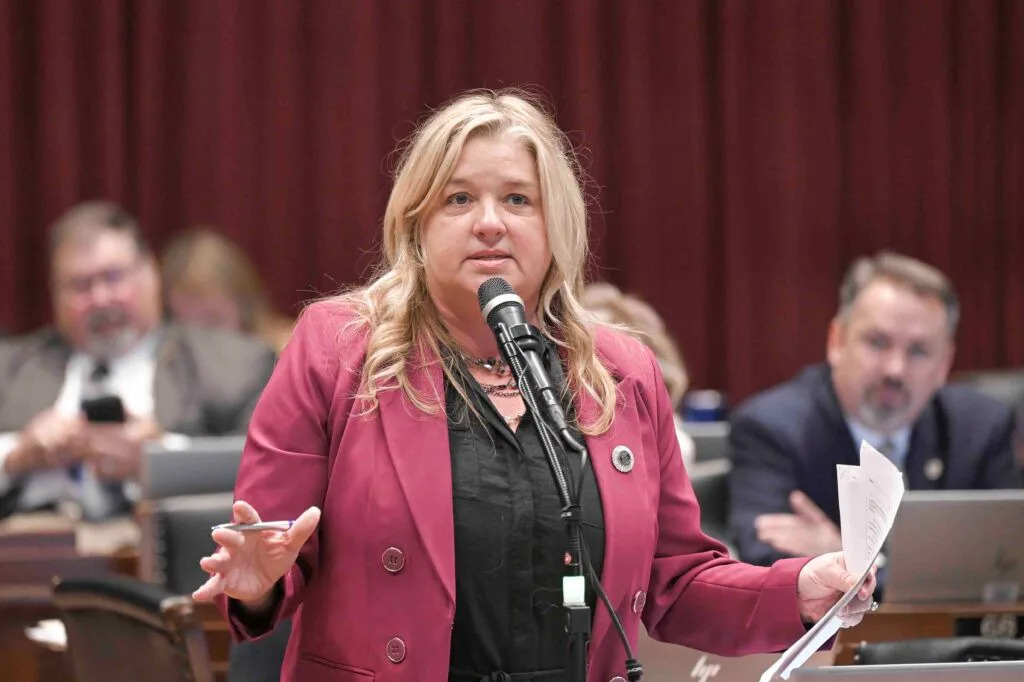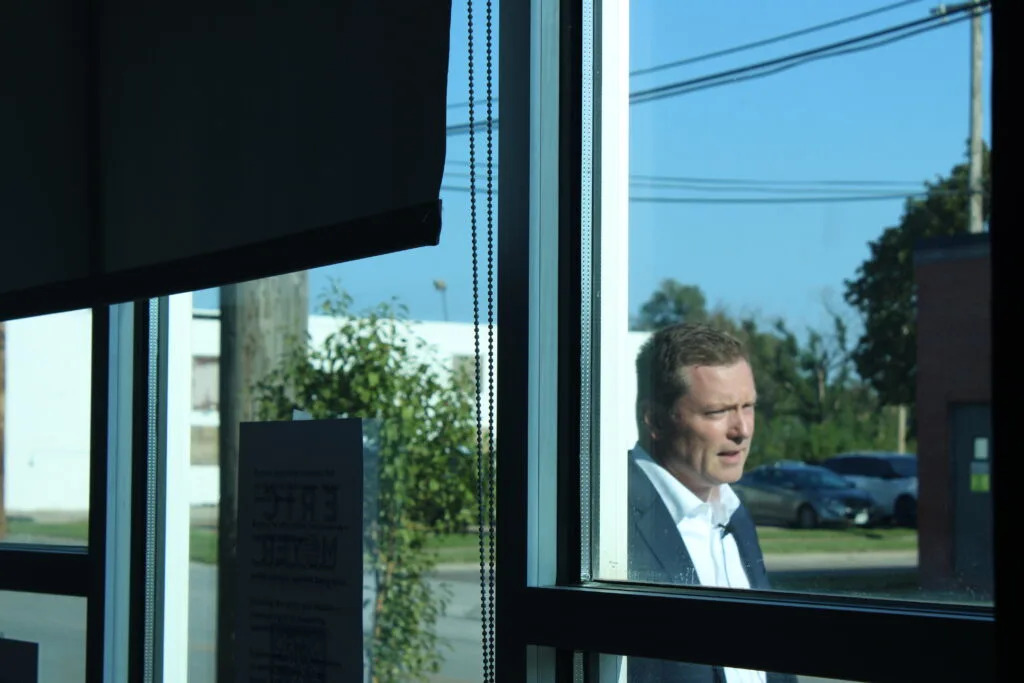
Caleigh Paquette, 26, a physician assistant for Brown University Health primary care offices in East Greenwich, is one of 153 recent college graduates named Wavemaker fellows this year. She is among 76 working in health care in the cohort. (Photo by Laura Paton/Rhode Island Current)
Caleigh Paquette prides herself on planning ahead.
The 26-year-old physician assistant laid the groundwork for her career as a teenager, starting clinical work hours at 18 in preparation for graduate school. She barreled through seven years of higher education with no breaks, landing a job with Brown University Health’s primary care offices in East Greenwich even before graduating from her master’s program in May 2024.
The one element not entirely pre-planned: $180,000 in student loan debt.
“When I got out of school, there were so many programs for repayment, forgiveness,” Paquette said. “No one teaches you about them, or what they mean, or what to choose. It was overwhelming.”
Especially now that federal loan forgiveness is under threat amid new borrowing caps and other changes by President Donald Trump’s administration. Paquette remains optimistic that the Public Service Loan Forgiveness program will remain, allowing her to wipe away whatever debt she owes after 10 years. But if the program changes or ends, she knows she could be saddled with six-figure, high-interest loans.
But she won’t have to shoulder all the debt on her own. Paquette will receive $24,000 in refundable tax credits over the next four years toward her student loans as a recipient of the state’s Wavemaker Fellowship.
The 2015 program was started by former Gov. Gina Raimondo to reduce the “brain drain” in science, technology, engineering and math. It offers recent college graduates $1,000 to $6,000 a year — depending on education levels — for up to four years to stay and work in the state. The program has since expanded to include health care workers and teachers.
Paquette was one of 153 recent college graduates, 76 of whom work in health care, named to the latest round of Wavemaker fellows in June. The ninth Wavemaker cohort was awarded a combined $2.5 million over four years.
Rhode Island Commerce, which administers the program, opened a new round of applications on Aug. 18, with an extra $500,000 earmark designated for primary care workers. The first-time carveout, approved by the Rhode Island General Assembly in 2024, seeks to ease the state’s primary care workforce shortage.
The price of persuasion
State officials lauded the half million-dollar earmark, which can help 20 to 40 doctors, nurse practitioners and physician assistants pay off debt. But will $24,000 in loan forgiveness be enough to persuade a medical school graduate with staggering debt to work in Rhode Island, when they could make more money elsewhere?
Not according to Dr. Michael Fine, former state health director who now serves as board president for the nationwide nonprofit, Primary Care for All Americans.
“Anything is good,” Fine said of loan forgiveness programs. “But I think that it takes $50,000 to $75,000 a year to move the needle for a medical school graduate to stay here.”
Massachusetts, for example, offers up to $50,000 a year for two years to help health care professionals who work in the state repay their student loans. The $100,000 maximum a health care worker can receive to pay off student loans in Massachusetts is more than four times the $24,000 maximum Rhode Island offers — on top of higher base pay across state lines for the same job.
Even if someone opts to stay in Rhode Island for the four years of student loan tax credits, there’s still no guarantee they will remain after that, especially with higher reimbursement rates enticing them across state lines, Fine said.
Sen. Pam Lauria, a Barrington Democrat and nurse practitioner who sponsored the 2024 legislation to designate tax credits for primary care workers, shared some of Fine’s concerns.
“There’s no one magic bullet that’s going to keep someone here,” Lauria said.
The Rhode Island General Assembly in its fiscal 2026 budget also added money to increase Medicaid reimbursement rates for primary care providers, while the state health insurance commissioner has directed commercial insurers to boost their repayment rates starting in January.
Lauria and Fine are part of a 21-member legislative study panel tasked with exploring how a new, state medical school could help improve the workforce shortage — and at what cost. A draft report published in June suggested an eyepopping $225 million cost over 10 years to open a public medical school at the University of Rhode Island. A final report with more detailed analysis on how to set up a state medical school is expected to be completed and unveiled within the next few weeks, Lauria said.
Scholarships vs. loan forgiveness
Lauria also sponsored legislation this year proposing a scholarship program for primary care students to pay for medical or graduate school, with a $1 million carveout for the year. The bill, and its House companion, failed to advance out of committee amid questions over implementation details.
Fine thinks scholarships are more effective than post-graduation loan forgiveness in helping create a workforce with community roots.
“Scholarships get us people long-term,” Fine said. “It’s a way for us to support kids or students who come from our communities, who might be first-generation students or not have the wherewithal to think of themselves as going to medical school.”
Anything is good. But I think that it takes $50,000 to $75,000 a year to move the needle for a medical school graduate to stay here.
– Dr. Michael Fine, former state health director, on the amount of state student loan support needed to attract and retain primary care workers
The Wavemaker program does not require recipients to live in Rhode Island, although they must work for a Rhode Island company to receive the refundable tax credits. A majority of recipients live in Rhode Island — 86% of those who received tax credits from 2019 to 2021, according to an 2023 analysis by the Rhode Island Office of Revenue Analysis. The revenue analysis report, which has not been updated, concluded the tax incentive program generally paid for itself by generating more revenue and boosting employment, even if not all of the program recipients needed tax credits to stay and work in Rhode Island.
The report also offered recommendations to improve data collection and reporting, as well as making it more equitable by potentially broadening the program to an automatic benefit rather than a competitive award. The report acknowledged this suggestion comes with a high cost to the state and would require more analysis.
Lawmakers have steadily increased funding for the Wavemaker program as its scope has widened. Health care workers, including those working in primary care were added in fiscal 2023, while teachers were able to qualify the following year. The extra $500,000 that the fiscal 2025 budget tacked on specifically for primary care workers adds up to a total of $4.1 million. The fiscal 2026 budget included an additional $2.6 million for the program, with no eligibility changes.
Administrative delays
Turning policy into practice has been slow.
No tax credits were distributed in 2025 because Commerce needed time to develop regulations governing expanded eligibility for teachers, said Matt Touchette, a Commerce spokesperson. The 2025 cohort marks the first time educators were able to receive awards.
The money set aside for primary care workers by lawmakers for fiscal 2025 has yet to be distributed because more time was needed to develop distribution and reporting regulations, Touchette said. While Wavemaker was available to health care workers starting in 2023, there was still no specific designation or tracking for primary care awardees.
The newly opened application round, which closes Oct. 13, will include the fiscal 2026 funding and carry over the $500,000 authorized for primary care workers a year ago. Commerce expects to announce awards to another 250 recent graduates this winter, Touchette said.
Touchette declined to comment on expected application numbers. Recent data suggests the program has seen a resurgence in popularity after the end of federal pandemic loan forgiveness and forbearance programs. Just over six in 10 applicants were accepted in the most recent round of funding, with 43% more applications than in 2022.
Paquette said she was “ecstatic” to receive an award, comforted by the financial boost.
“When we were doing rotations, I was a little disappointed at how much I loved internal medicine and family medicine,” Paquette said. “That’s not where the money is. You spend all this money on school, all this time, the hardest three years of my life, and your passion takes you to something that makes the least amount of money.”
Her starting salary is $120,000. The Wavemaker award covers two-thirds of her $9,000 annual loan payments for the next four years.
“I am going to be in really good shape starting out,” she said.
SUBSCRIBE: GET THE MORNING HEADLINES DELIVERED TO YOUR INBOX








Comments